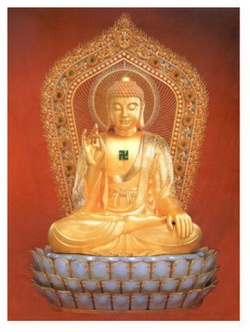Difference between revisions of "What is Mindfulness?"
(Created page with "thumb|250px| <poem> Mindfulness as a principle is receptive, open, non-interfering and non-developmental, and its primary method is Just Sitting. Receptive ope...") |
|||
| Line 47: | Line 47: | ||
[http://www.kamalashila.co.uk/styled-39/mitrastudy/styled-49/ www.kamalashila.co.uk] | [http://www.kamalashila.co.uk/styled-39/mitrastudy/styled-49/ www.kamalashila.co.uk] | ||
[[Category:Mindfulness]] | [[Category:Mindfulness]] | ||
| + | [[Category:Kamalaśīla]] | ||
Revision as of 11:09, 22 July 2013
Mindfulness as a principle is receptive, open, non-interfering and non-developmental, and its primary method is Just Sitting. Receptive open-minded awareness is the basis for the system of training in mindfulness taught by the Buddha via the four satipatthanas – domains or fields of mindfulness – in the Satipatthana Sutta, Majjhima Nikaya 10.
Mindfulness practice from Kamalashila's 'Buddhist Meditation'
Four Fields of Experience
The immediate concern of mindfulness is the question, ‘What is happening, right now, in my experience?’ This enquiry demands continual curiosity, receptivity and openness and this gives birth to the Just Sitting meditation practice as well as Walking Meditation.
The Buddha identified four key aspects of human experience: our body, our current feelings, our general mental state, and the particular objects in our mind at present. He called them the ‘domains of mindfulness,’ four fields of experience that unfold out of one another.
Try taking a little of your attention away from reading this, and settle it in your body. Take your awareness through the different parts of your body and experience whatever sensations you find there. There may be a little resistance at first, but relax and continue and you’ll get into it. (A tip: don’t skip to the next instruction until you are directly experiencing what the present one is referring to.)
Feel the skin on your face, and the variety of different physical sensations there. You will find tensions, tingles and a whole variety of sensations. Experience these for a while in a general sort of way and relax into the realm of body sensation. Then allow your attention to shift from the sensations in the eyes to those at the lips, then to the forehead and scalp. As you do this, you may feel other parts of your body relaxing in sympathy. Move down next to your shoulders, upper arms, forearms, wrists, palms, fingers and thumbs. Then take the attention minutely down through the rest of your body. First the chest and abdomen, then round to the back and down the spine, then the hips, buttocks, thighs, knees, calves, ankles, feet, and toes – experiencing the sensations right down to the tingles on the soles of your feet.
A body scan is a good way to prepare for any meditation, because bodily awareness provides a way in to awareness of the subtler aspects of experience – feelings, emotions, thoughts – that you work with in meditation. Mindfulness works from the ground up. The fact that you are in touch with your body allows you to tune into feeling; the fact that you are in touch with feeling (pleasant, painful or neutral) allows you to tune into your emotions and their accompanying thoughts – for example when you are angry you have angry thoughts, when greedy you have greedy thoughts and when hungry you tend to think about food. Angry mind, greedy mind and hungry mind are examples of moods or general mental states, the third field of mindfulness. When you’re in the habit of noticing moods, the mind gains a new spaciousness in which you more readily notice the specific objects of your attention. Here begins the more complex and active fourth field of mindfulness, that of (objects of) attention. It enables you to check the effects of your moment-by-moment activity against your aspirations (and some particular teachings of the Buddha) and make choices in the ways you respond.
1 Body
Awareness of the body is key. Consider the great joy of being physically aware. If you let your awareness flow along with what you are doing physically, even the simplest sensations - your feet on the ground, the air on your skin - can become rich and absorbing. It brings richness and significance into day to day life.
The really crucial thing bodily mindfulness does is bring you into the present. It brings you down to earth, out of the clouds of proliferating thought. At first you may well resist letting those go, but with a little persistence you’ll appreciate the reality of the here and now. When you bring awareness to the body, your activities begin to assume a certain harmony. You feel more in touch, more on the ball. And this is a pleasure, so you relax. Your whole approach to life slows down, yet you don't get less done; indeed, by tuning in to a more effective way of living, you achieve more.
Body awareness can teach you a lot about how your posture and movement mirrors how you feel. You can easily see in others that the body holds habitual attitudes and emotions. You can also feel it your own physical sensations, postures and movements. Facial expressions give out the most obvious messages, but body language instantly communicates interest, uncertainty, or aggression too. On seeing a joyful spring in someone's step, you know instinctively they are happy. Or you sense immediately that something is wrong when a friend even slightly bows his head and rounds his shoulders.
2 Feeling
One of the first changes that happen once you get in touch with the physical body is that you more readily experience what you feel across a spectrum from pleasure to pain. So ask, on the basis of that body scan you just did – is the physical sensation as you sit here (or maybe you’re standing or lying down), pleasant, or is it not? No doubt it seems more complex than that, but focusing on the pleasure/pain axis opens a door into seeing more deeply. Feelings can also be mental – your ideas, memories and perceptions feel pleasant, painful etc. These feelings might seem quite obscure, but still, making the enquiry has a powerful effect.
Then it’s easier to connect with the more complex emotions running around in the mind. If your body experience is a bit unpleasant, are you perhaps also responding with irritation, embarrassment, aversion or fear? If it’s pleasurable, there will be a different range of emotions – but the point is that from the perspective of meditation it’s very useful to notice more clearly what goes on inside. For example let's say you are sitting here, reading, aware of a particular set of sensations in your body that you normally associate with hunger. The sensations are slight yet you can acknowledge that they’re slightly unpleasant. With that acknowledgement you can see that (as usual) you’re already responding with an emotion – at this stage one of equanimity. OK, you’re a little peckish but it’s no big thing. You are more interested in continuing to read. Later on you’d start getting uneasy, even having strong cravings and thoughts about food. Alternatively, if you hadn’t noticed the basic discomfort at all, you might have become confused without knowing why and then got distracted.
‘Feeling’ here means pleasure or pain, strong or weak. These feelings are automatic and people have little control over them: chocolate automatically gives most of us pleasure; toothache automatically gives us pain. Feeling is usually so overlaid by emotion (and streams of emotionally-loaded thinking) that you don’t see it as a separate layer. Yet its nature is different. Chocolate may produce an automatic feeling of pleasure, but that pleasure need not be followed by craving for more, or planning how to get it. That craving and planning would be a further, emotional, overlay in which you might expend enormous quantities of energy. Toothache (painful feeling) may have a potential to draw you down into a depression (negative emotion), but you do have some degree of control over that which, even when apparently very slight, is the space where the pattern can be changed.
Mindfulness of feeling is an essential transformational art, because people are so accustomed to living in a a secondary reality of complex emotions and thoughts that they are cut off from raw experience. The essence of Buddhist practice is staying, as far as possible, with the central core of sensation and feeling, before the habitual emotional reactions kick in. From that core it is possible to change the knee-jerk responses. Emotions are always responses to some feeling, somewhere. By carefully watching your inner reactions you’ll see the continual pattern of feeling/response, feeling/response, feeling/response. You’ll see the basic attraction to whatever gives you pleasure and the basic repulsion to anything that gives you pain, attraction and repulsion being the most basic emotions: you either want to move towards or away from feelings.
When we feel inadequate to deal with an emotion one tendency is to cut off. It is easy to feel uncomfortable with strong emotions like anger or sexual desire which can lead many people to deny them and become distanced from their experience. It’s also just as common to become gripped by such an emotion and start acting out of it more or less blindly, often at someone else’s expense. In bringing you more deeply in touch with feeling and emotion the purpose of mindfulness is to cultivate skilful, helpful responses. You can't change your feelings, for pleasure and pain will arise whatever you do. What you can do is learn to change the way you respond to those feelings –you can learn to develop patience, love and compassion, and to let go impulses towards craving or hatred.
This also involves awareness of thinking, since thought and emotion are more or less inseparable, each providing a key to the other. Once you notice a thought, the underlying emotion becomes readable. Connect with an emotion, and you can see the thought process that’s going on simultaneously. Such techniques are essential to the training. Often you have no idea what your thoughts are, even though you spend long hours pursuing them. How elusive they can seem, billowing forth like clouds or darting like minnows through obscure waters. Mindfulness practice develops the ability to spot thoughts and know the direction they are pursuing. In particular, you learn to see where a train of thought comes out of some emotion – whether, for example, an opinion is actually a rationalisation of your preference or the result of objective consideration; or if the way you are describing things to yourself is useful or an unhelpful distortion based on fear or prejudice. Looking more closely allows you to clean up your thinking by 'testing statements on the touchstone of conscience' as D. H. Lawrence puts it. Clarifying the relationship between your thoughts and emotions will allow you to re-discover what you actually think and feel. Most of your thoughts are a mish-mash of other people's ideas, and that’s normal – everyone takes in ideas from parents, friends, books, media and the internet. But fully facing the power of these influences is an important step towards thinking more clearly and independently. It increases your ability to reflect or direct our thoughts – which is a key quality, as we’ll see later when we come to cultivating insight.
3 Mood
“And how, monks, does he in regard to the mind abide contemplating the mind?
“Here he knows a lustful mind to be ‘lustful’, and a mind without lust to be ‘without lust’; he knows an angry mind to be ‘angry’, and a mind without anger to be ‘without anger’; he knows a deluded mind to be ‘deluded’, and a mind without delusion to be ‘without delusion’; he knows a contracted mind to be ‘contracted’, and a distracted mind to be ‘distracted’; he knows a great mind to be ‘great’, and a narrow mind to be ‘narrow’; he knows a surpassable mind to be ‘surpassable’ and unsurpassable mind to be ‘unsurpassable’; he knows a concentrated mind to be ‘concentrated’, and an unconcentrated mind to be ‘unconcentrated’; he knows a liberated mind to be ‘liberated’, and an unliberated mind to be ‘unliberated.’
The section on ‘Mood’ from the Satipatthana sutta, the Buddha’s main teaching on mindfulness
The third field of experience as mapped out by the Buddha is a comparatively simple one. It’s your current mental state, or what you could call your mood. According to Robert E. Thayer, a mood is a relatively long lasting state that is volitional, and contains various connected thoughts and emotions, though differing from from those thoughts and emotions ‘in that (the mood is) less specific, less intense, and less likely to be triggered by a particular stimulus or event.’
Hello! How are you today – somewhat needy, irritated, obsessive? Tunnel-visioned, self-absorbed? Confused, distracted, can’t focus? Or crystal clear, concentrated, never been brighter? Like glancing at the sky and observing the weather, it’s easy enough to roughly gauge your current mind-set. However I suspect you don’t do it very often, even though it’s mostly just a question of deciding to take a look, and even though you’d benefit, as would your friends, if you looked more often. To know quite consciously for example that your mind is ‘contracted’ – perhaps due to lack of sleep – is helpful because if you know, you’ll be less inclined to overstretch and harm yourself, or lash out at others. It is also helpful because when you understand your mental state, you tend to stay connected with your experience. And this is perhaps the most important thing of all; you need to be sensitive to your experience. So many problems arise when you don’t even notice you are in a particular mental state – irritated, for example – and go off unawares in a mental bubble, disconnected from the reality of your impressions, feelings and emotions. Alienation makes you difficult to live and work with, even apart from its dissipation of your energies and making you, in the long term, less happy.
4 Objects of Attention
The fourth and in some ways the subtlest field of experience consists of your moment-by-moment attention to the particular objects that are in your current window of awareness. There are the objects of your physical senses, the familiar sights, sounds, smells, tastes and touches, along with the current thought constructions, perceptions, recognitions, memories – every kind of image within what Buddhism calls ‘the mind sense’. All these phenomena come and go in your attention so fast that you miss most of the detail. As meditation becomes more concentrated and your mindfulness grows more thorough you’ll notice more of them; it is quite astonishing sometimes to see how much actually passes through the mind.
Of course, these objects of attention are equally the concern of the other areas of mindfulness, but here the purpose is a little different. In the Satipatthana Sutta the Buddha recommends that you contemplate the experiences in every field in a way that is ‘diligent, clearly knowing, and mindful, free from desires and discontent in regard to the world.’ He suggests that you explore each of these internally and externally, and that you are aware of their arising, passing away, and both. You should be mindful of each to the extent that is necessary for knowledge and continuous mindfulness and maintain a spirit of independence, ‘not clinging to anything in the world’.
In context of the particulars of attention the Buddha now additionally asks you to measure your present experience against a number of his key teachings including the Five Hindrances to concentration. In this way the practice of mindfulness becomes a complete training in Enlightenment – the first three fields training you in a clearer experience of your life and the fourth mapping the moment by moment detail of your experience against various teachings that may be used to transform it.




